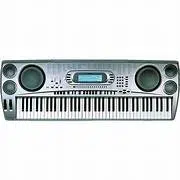Loading ...
Loading ...
Loading ...

E-34
733A-E-036A
❚
NOTES
❚
• When the keyboard is shipped from the factory, the user area (tones
200 to 231) contain the same tones as tones 128 through 159.
• You cannot use a drum set tone (192 to 199) as the basis of a user tone.
• Whenever you save a tone and assign it one of the tone numbers in the
user area, any tone data previously assigned to that number is replaced
with the new data.
• The keyboard comes with a built-in lithium battery that supplies power
to the memory to retain memory contents while keyboard power is turned
off. See “Lithium Battery Precautions” on page E-4 for important infor-
mation about the lithium battery.
• You can use the keyboard’s MIDI capabilities to save your original tones
to a computer or other external storage device. See “Bulk Sending Key-
board Data” on page E-65 for details.
• With the WK-1800, you can use the built-in disk drive to save original
tones to diskette. See “Using the Floppy Disk Drive (WK-1800 Only)” on
page E-67 for details.
Creating a User Tone
Use the following procedure to select a preset tone and change its
parameters to create a user tone.
1.
First, select the preset tone you want to use as a basis
for your user tone.
2.
Press the SYNTH button.
• This causes the indicator lamp next to the SYNTH button to
light and displays a screen that shows whether the tone you
selected is a DCO1 or DCO2 tone.
3.
Use [ ] and [ ] to display the parameter whose set-
ting you want to change.
• Each press of [ ] or [ ] changes to the next parameter. See
“Parameters and Their Settings” on this page for informa-
tion about each parameter.
4.
Use [+] and [–] to change the setting of the currently
displayed parameter.
• You can also use the number keys to input a value to change
a parameter setting. See “Parameters and Their Settings” be-
low for information on setting range for each parameter.
5.
If the preset tone you selected in step 1 is a 2DCO
tone, press [ ] twice to display the DCO2 parame-
ters.
6.
Repeat steps 3 and 4 to set the DCO2 parameters.
• Press [ ] two more times to return to the DCO1 parameters.
7.
Play something on the keyboard.
• To save the tone you created, perform the procedure under
“Naming a User Tone and Storing It In Memory” (page E-
35), starting from step 2.
• To exit user tone creation and return the tone to its original
parameters, press the SYNTH button twice or the TONE but-
ton once.
Parameters and Their Settings
The following describes the function of each parameter and also shows
its setting range.
■
PCM Set (000 to 288)
This parameter switches the digitally sampled waveform.
■
Amp Envelope Set (000 to 288)
This parameter controls volume characteristics over time.
■
Attack Rate (001 to 127)
This parameter controls the speed of the attack. The greater the val-
ue, the faster the attack of the selected amp envelope.
Chrch
O
r
g
A
e
nv
0
26
PCM
050
Atk
R127
Aen
v050
AMP
ENVELOPE
00 FLAT
01-17 VIBRATO
18-45 OTHERS
DECAY
SUSTAIN
PITCH
ENVELOPE
MIN
MAX
FULL RANGE
CHORD
CASIO CHORD
SONG
FINGERED
PATTERN
EXTERNAL
INTERNAL
UPPER1
CH 1
UPPER2
CH 2
LOWER1
CH 3
LOWER2
STOREBANK
CH 4
ACC VOL.
CH 5
CHORD1
CH 6
CHORD2
CH 7
CHORD3
CH 8
BASS
CH 9
RHYTHM
CH 10
TR1
CH 11
TR2
CH 12
TR3
CH 13
TR4
CH 14
TR5
CH 15
TR6
CH 16
7 8 9
4 5 6
1
0
2 3
PARA METER RESET:
DELETE
/YESS/NO
MAIN MANU/
CHANNEL VO LUME:
SUB MANU/
CHANNEL SELECT:
Numberkeys
TONE
SYNTH
–]
Cursorkey
s
DCO 1
Dco 2
WK-1800/1600(E)-32~38 03.7.31, 5:21 PMPage 34 Adobe PageMaker 6.5J/PPC
Loading ...
Loading ...
Loading ...
